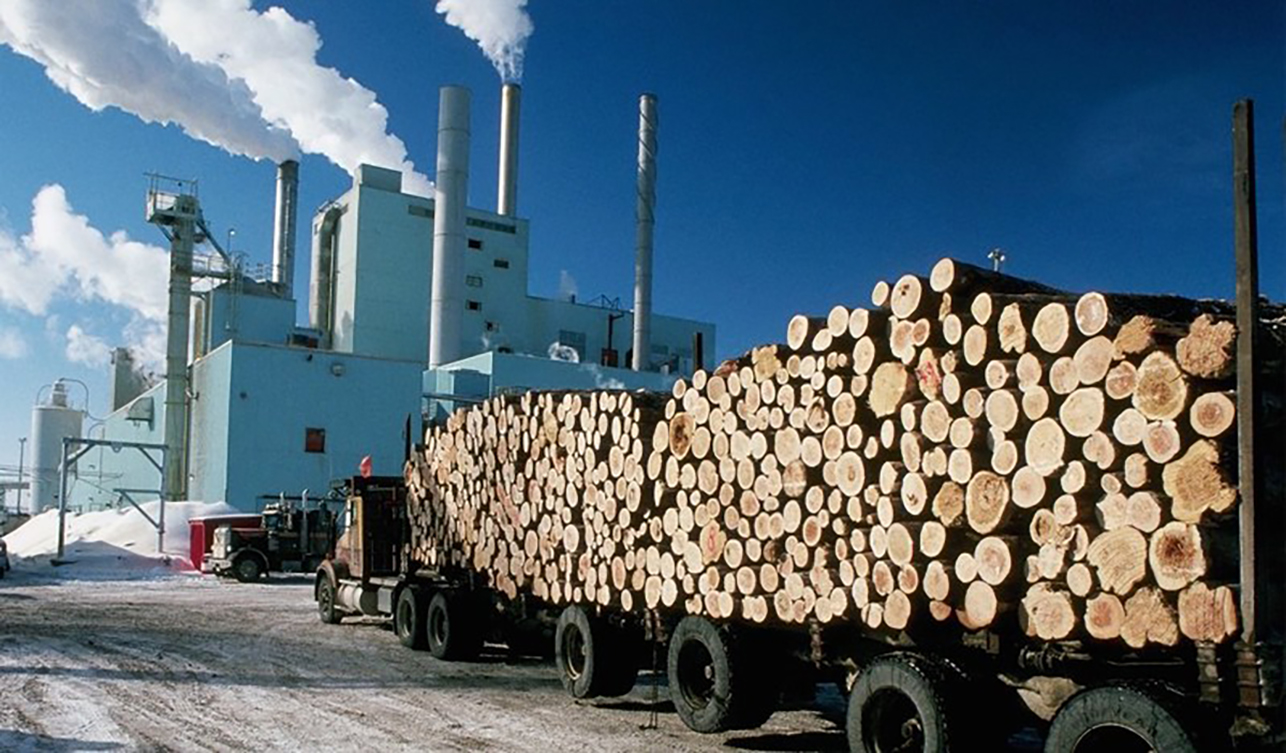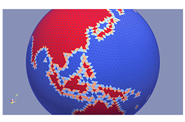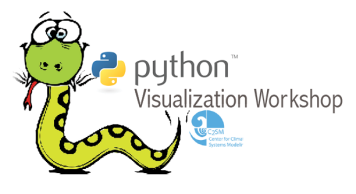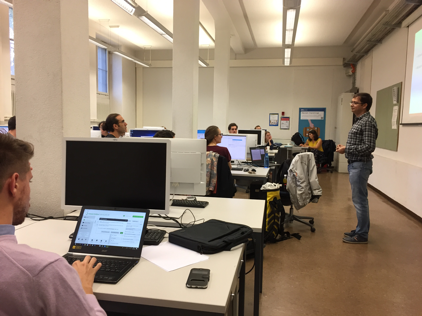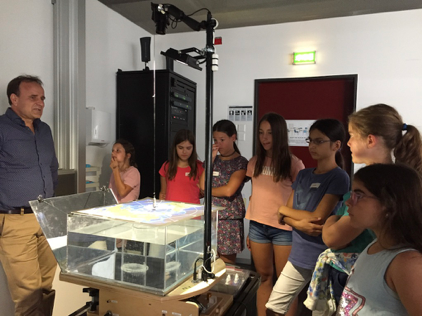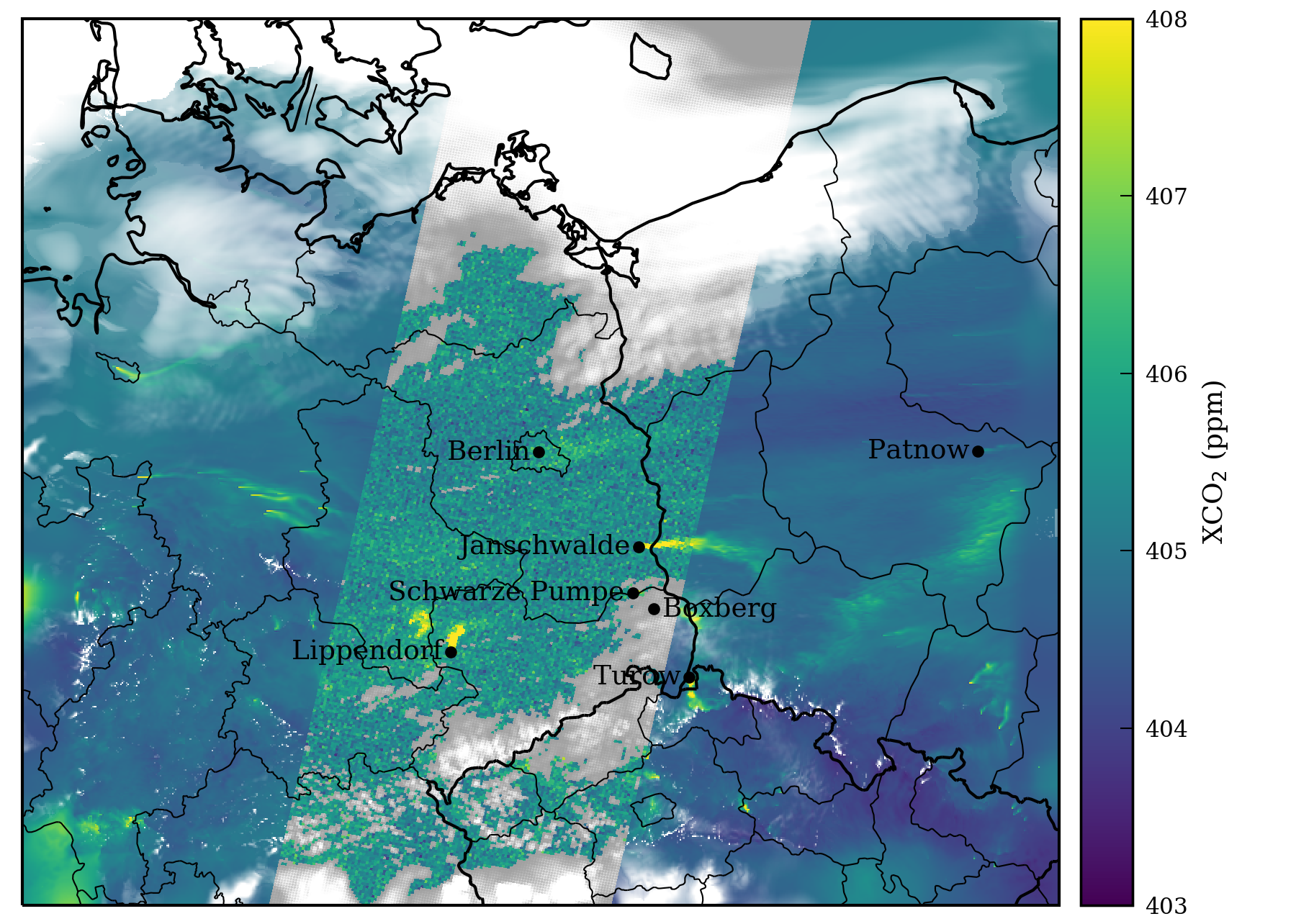C2SM Newsletter vol. 27
Download newsletter as Downloadpdf (PDF, 6.8 MB)vertical_align_bottom.
Topics in this Newsletter - September 2018
- News from the Steering Committee
- Global modelling activities
- Regional modelling activities
- Scientific visualization activities
- Visualization in python workshops 2018
- Data Management Task Force
- News Swiss Climate Change Scenarios CH2018
- Outreach activities: IAC Girls' Day 2018
- News from C2SM groups
- News from MeteoSwiss
- News from Empa
- PhD defenses in the C2SM community
- Upcoming events of interest
- Announcement: Latsis Symposium on "High-resolution climate modeling: Perspectives and Challenges"
- Paper: Greenhouse gas fluxes over managed grasslands in Central Europe
- Paper: Future snowfall in the Alps
- Paper: The chemistry-climate model ECHAM6.3-HAM2.3-MOZ1.0
- Paper: The many possible climates from the Paris Agreement's aim of 1.5°C warming
- Paper: A global historical data set of tropical cyclone exposure (TCE-DAT)
- Paper: Marine Heatwaves are threatening marine ecosystems
- Paper: Regional climate models reduce biases of global models and project smaller European summer warming
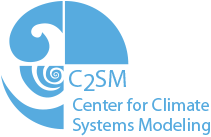
News from the Steering Committee
We regularly include information from the Steering Committee (SC) meetings and about the decisions that have been taken.
C2SM supports Atmosphere over Mountains Experiment (TEAMx)
At the last Steering Committee Meeting (SC) in May 2018, C2SM member Marco Arpagaus introduced the SC to the new research programme «Transport and Exchange Processes in the Atmosphere over Mountains Experiment» (TEAMx), coordinated by Prof. Mathias Rotach of the University of Innsbruck. TEAMx builds on the previous Mesoscale Alpine Programme (MAP) initiative and aims at investigating atmospheric processes above mountainous terrain and the interactions between mountains and the atmosphere. It shall bring together observational and modelling infrastructures in several countries to foster the understanding of interactions in the mountainous atmosphere over a broad range of scales. The envisioned program also includes regional climate modelling. The observational phase, i.e., a comprehensive field experiment, is planned for 2022-2025. To support the latter, the high-resolution model ICON-LAM is envisioned to be applied for research purposes. By signing the TEAMx Memorandum of Understanding (MoU), the partners declare to work together with others to further expedite the understanding of the atmosphere over mountainous terrain. Those partners that financially commit to TEAMx contribute to funding a project office position for the duration of two years, whose tasks among others will be project coordination and fundraising.
The SC concordantly decided to sign the MoU and to contribute kCHF 10 from C2SM core funds to the programme with the following motivation: TEAMX includes a range of goals that are supported by C2SM. In particular, it matches C2SM’s modelling strategy to apply the ICON model and thus can be regarded an investment in the center’s future. It also matches the strategies of our C2SM partners MeteoSwiss and WSL both regarding contents and timing. For WSL, the programme very well suits their research focus «Climate change impacts on the Alps». The initiative will be presented again to the C2SM members at the Plenary Assembly on 6 December.

Swiss Climate Summer School 2019: “Carbon and climate in a 2° world: getting out of the fossil fuel carbon budget crunch”
November. Information on the school will soon be available from the external pageSwiss Climate Research webpagecall_made.
Short summary: The global warming target of 2°C implies a tightly limited fossil fuel emission budget for the entire 21st century. Yet the current trends in the fossil fuel emissions suggest that this budget is consumed within the next three decades. With conventional mitigation and adaptation options not sufficiently exploited, humankind may need to deploy unconventional methods to meet its climate target.
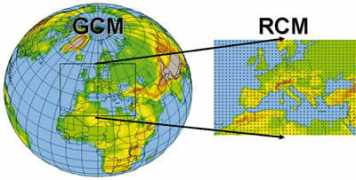
Regional modelling activities
Regional modelling activities for the spring and summer of 2018 have focused on producing a release of the EXTPAR software that is fully compatible with the current COSMO and ICON versions, as well as developing a technical test suite for EXTPAR and automation of testing with the Jenkins tool. Additionally, an online anthropogenic emissions module has been developed in the gpu version of COSMO for the group of Dominik Brunner at EMPA. This module allows for the online calculation of emissions on the gpu architecture, eliminating the need for costly pre-processing steps.
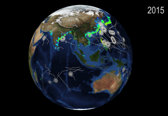
Scientific visualization activities
Recently we finished and delivered two out of our several interesting projects:
• Animations for the LongRunMIP (model intercomparison) study (Dr. Maria Rugenstein, group: Prof. Reto Knutti) and
• A customized tool developed for visualizing tree-growth simulation data (group: Prof. Harald Bugmann)
Furthermore, we made progress on the following projects:
• In context of the C2SM flagship animation we animated high-resolution data from the CESM model. Part of this data will be used together with COSMO data at different resolutions to highlight the regional and global climate processes;
• We also created another animation showing tropical cyclones and damage caused by them. We are continuing to further improve and develop it together with Prof. Bresch;
• We animated data fields from the Swiss climate change scenarios (CH2018) project and are working together with the project coordinators to iteratively converge towards the desired animations;
• As a part of the visualizations for the CH2018 project, we are currently trying to set up a Web Map Services (WMS) server. Once ready it should allow us to display georeferenced raster data on platforms like Swiss Topo. This may be of interest to other groups as well.
As the year is slowly coming to an end we are again on a lookout for new and interesting visualization projects for the upcoming year. We still have available time-slots to accept new project proposals. Therefore, we ask our members to take advantage of this and submit their visualization project ideas to us. Our visualization expert Tarun Chadha can be consulted at any-time during the preparation of a proposal.
As communicated previously, apart from working on longer directly paid projects, we continue to provide free-of-charge short duration (up to 2 days) visualization support to individual researchers. Therefore, if you have any questions or require support, feel free to contact .
For more information on our activities and recent animations, please visit our scientific visualization page.
Based on the strong interest from the community, we will offer the course again in early summer 2019, the date is yet to be announced.

Data Management Task Force
As an outcome of the first C2SM’s Data Management Info Event and Workshop hold in spring this year, a task force was established to further develop the ideas from the workshop. Current participants in the task force are Urs Beyerle (ETH/C2SM; Chair), Tina Schnadt (C2SM), Gabriela Aznar (group D. Bresch, ETH), Sylvaine Ferrachat (group U. Lohmann, ETH), Matthias Münnich (group N. Gruber, ETH), Michael Sprenger (group H. Wernli, ETH), Richard Wartenburger (group S. Seneviratne, ETH), Stephan Henne (group D. Brunner, Empa), Gian-Kasper Plattner (WSL).
The task force has already met twice. Further meetings are planned. The first primary goal is to develop recommendations and possibly good practice guidelines on data management in weather and climate modeling and related research fields. As a first activity, the task force has discussed the SNSF requirements for data management. Examples of SNSF Data Management Plans will be provided soon to our community. For more information please see the C2SM data management wiki.

News Swiss Climate Change Scenarios CH2018
Heatwaves across the country, torrential rainfall in Lausanne, and exceptional dryness - these headlines from 2018 sound remarkably similar to the new climate scenarios CH2018. Especially the summer has been a textbook illustration of what climate change means for Switzerland. In a historical perspective, 2018 has been an exceptional year. In the context of our future climate, however, the heatwave and dry periods that we have experienced this year appear more "normal". The climate scenarios CH2018 will help us to better understand how climate change is shifting the climatical norms we are accustomed to. Containing information from the average to the extreme event, and from the regional to the local scale, CH2018 provides the most detailed glimpse of the climatic future of Switzerland so far.
We are now approaching the end of the project, and hence the publication of the new scenarios at great pace. We are currently using all efforts to prepare this event “Neue Klimaszenarien für die Schweiz”, which will take place on November 13 this year at ETH. external pageDetailed information is now available, and registration will be opened on 17 September 2018call_made. Admission to the event is free.
The program contained multiple workshops in which simple instruments were built such as a barometer and a sling psychrometer, and which demonstrated how processes in the atmosphere work, e.g. the general circulation and clouds. C2SM community member Daniel Steinfeld and member Ulrike Lohmann explained weather and climate in interactive presentations, while C2SM chair Nicolas Gruber demonstrated how weather can be “captured” in a rotating tank. Finally, in a balloon competition the junior researchers estimated where their balloon will land based on trajectory calculations provided by community member Michael Sprenger. Two cards were returned by their finders. The two lucky girls who sent these cards won tickets for Technorama in Winterthur. Finally, we would like to sincerely thank all volunteers from IAC and C2SM who made this event a success!

News from C2SM groups
Grassland sciences group
• Grass-fed livestock – a climate solution? Watch a video on external pageGrazed and Confused?call_made which sets out to answer the question: Can grazing livestock help to mitigate climate change? If so, by how much? A product of our joint project DEVIL. (4 July 2018)
• The Grassland Sciences group participated at the Kangaroo goes Science Day. The hundred best girls of class level seven who had taken part in the Kangaroo Mathematics Competition in March were invited to visit ETH Zurich. Twenty four of those visited our lab to experience hands-on science. They learned about the responses of plants to drought and flooding: they measured stomatal conductance, observed reduction in CO2 concentations due to photosynthesis and examined stomata under the microscope. The girls were coached by Annika Ackermann, Anna Gilgen and Sabina Keller from our team. Watch a short movie here. (22 June 2018)
• New funding: The kick-off meeting of our new H2020 project SUPER-G on SUstainable PERmanent Grassland systems and policies was held in Lisbon, Portugal. The overarching goal is the sustainable use of permanent grassland systems and the development of policies in Europe. Lots of info, new colleagues and a great field trip to the Alentejo region with their Montado systems (cork oaks over pasture) was an excellent start. (13 to 15 June 2018)
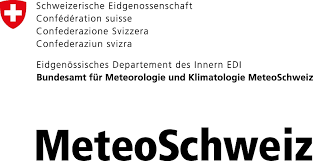
News from Meteoswiss
New CH2011 Extension
A fourth extension of the CH2011 Swiss Climate Change Scenarios has been published at external pagewww.ch2011.chcall_made. The extension establishes a link between the previous CH2011 and the upcoming external pageCH2018 scenarioscall_made. It provides local climate scenarios for Swiss sites based on the ENSEMBLES regional climate model experiments used in CH2011 but employing quantile mapping, i.e. the bias correction and downscaling approach used in CH2018, instead of delta change. Transient and bias-corrected daily scenarios are provided for 15 GCM-RCM model chains and for 28 temperature and 27 precipitation stations in Switzerland. The work has been carried out within the SBF-funded ELAPSE project which, in turn, was related to the external pageEU COST-Action VALUEcall_made. The full CH2011 Extension Report is available external pageherecall_made.
Citation: Kotlarski, S., M. Ivanov, and C. Schär, 2017: Bias-corrected transient scenarios at the local scale and at daily resolution, CH2011 Extension Series No. 4, Zurich, 21 pp.
ESA project SMARTCARB completed
SMARTCARB was a 1.5 years project funded by the European Space Agency (ESA) to investigate the potential of a future constellation of CO2 satellites with imaging capability in combination with NO2 or CO observations to quantify the CO2 emissions from large cities and power plants.
Such a constellation has been suggested by the European Commission as a contribution to a global CO2 emission monitoring system and is planned to be established in the framework of the European Earth Observation Programme Copernicus. Together with its partners from C2SM and MPI Jena, Empa conducted an “Observing System Simulation Experiment” using the COSMO model with an extension for greenhouse gases and other tracers. In this experiment, kilometer-scale simulations of CO2, NO2 and CO were conducted using detailed hourly maps of anthropogenic emissions and biospheric CO2 fluxes over a domain centered over Berlin and including several coal-fired power plants in Germany and Poland. The model output fields were sampled along the hypothetical tracks of the future satellites and combined with measurement errors to generate highly realistic synthetic satellite observations. The synthetic observations were then analyzed for their potential to quantify emissions using both inverse modelling and mass balance approaches.
C2SM played a critical role in the project by porting the tracer extension to the gpu version of COSMO, which permitted running simulations at very high resolution. The results of the project will provide important guidance for ESA for the design of the future satellites.

PhD Defenses in the C2SM community
We congratulate our community members for their successfully completed PhDs!
Erkan Ibraim: Development and field application of a laser spectroscopy based method for on-site analysis of N2O isotopocules to constrain source processes of emissions, ETH Zurich, 28 September 2018
Adel Imamovic: Theoretical and Numerical Studies of Moist Summer Convection over Orography and Soil-Moisture Heterogeneities, ETH Zurich, 30 July 2018.
Remo Dietlicher: Ice clouds: from ice crystals to their response in a warming climate. ETH Zurich, 5 July 2018
Katty Huang: Aerosol effects on climate, with an emphasis on the Arctic. ETH Zurich, 22 June 2018
Martin Stolpe: Dependence of Climate Change on the Climatological Base State and Internal Variability. ETH Zurich, 22 June 2018
Anand Kumar: Enhanced Ice Nucleation Efficiency of Mineral Dust Particles in Ammonia/Ammonium Solution Droplets, ETH Zürich, 18 June 2018
Simone Brunamonti: Balloon-borne measurements of temperature, water vapor, ozone and aerosol backscatter at the southern slopes of the Himalayas, ETH Zürich, 1 June 2018
Ana Franco: Modeling the variability, trends and future changes in ocean acidification in the Humboldt Current System, ETH Zürich, 24 May 2018
Laura Schuler: The role of tree species diversity for maintaining ecosystem services under multiple disturbances and climate change. ETH Zurich, 17 May 2018
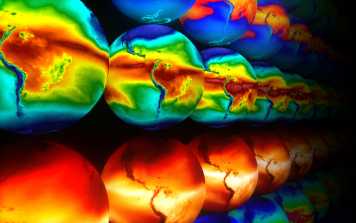
Upcoming events of interest
• 13 November 2018: Neue Klimaszenarien für die Schweiz – the launch event presenting the new Swiss Climate Change Scenarios resulting from the CH2018 project. external pagePlease register now!call_made
• 6 December 2018: C2SM Plenary Assembly of the C2SM members.
• 6 December 2018: C2SM Community Day. We present C2SM and give an overview of our activities to our community members.
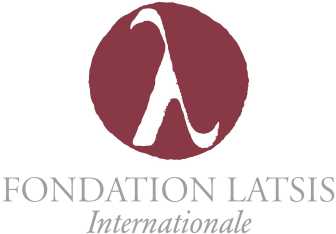
Announcement: Latsis Symposium on “High-resolution climate modeling: Perspectives and Challenges”
C2SM member Christoph Schär together with colleagues from the external pagecrCLIM projectcall_made have been awarded the 2019 Latsis Symposium at ETH. The symposium will be organized together with the 3rd GEWEX Workshop on Convection-Permitting Climate Modeling and will take place on 21-23 August 2019 at ETH Zurich.
The event will focus on scientific and technical challenges related to km-scale global and regional climate modeling. It will bring together scientists from the areas of climate modeling, computer sciences and numerical methods – with the aim to address climate and weather time scales, the water cycle and extreme events, as well as emerging supercomputing platforms and software strategies.
There will be oral and poster sessions, several invited talks on key topics, and multiple opportunities for discussions and networking.
For more information, please visit the Latsis 2019 symposium webpage.
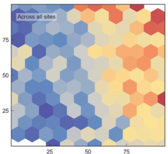
Paper: Greenhouse gas fluxes over managed grasslands in Central Europe
Central European grasslands are characterized by a wide range of different management practices in close geographical proximity. Site‐specific management strategies strongly affect the biosphere–atmosphere exchange of the three greenhouse gases (GHG) carbon dioxide (CO2), nitrous oxide (N2O), and methane (CH4). The evaluation of environmental impacts at site level is challenging, because most in situ measurements focus on the quantification of CO2 exchange, while long‐term N2O and CH4 flux measurements at ecosystem scale remain scarce. Here, we synthesized ecosystem CO2, N2O, and CH4 fluxes from 14 managed grassland sites. We found that grasslands were on average a CO2 sink, but a N2O source, and either a CH4 sink or source. The net GHG balance (NGB) of nine sites where measurements of all three GHGs were available was found to be negative and ranged between −2,7 and −58 g CO2‐eq. m−2 year−1, with N2O and CH4 emissions offsetting concurrent CO2 uptake. The only positive NGB was found for one site during a restoration year with ploughing. The predictive power of soil parameters for N2O and CH4 fluxes was generally low and varied considerably within years. The application of animal slurry to grasslands increased N2O and CH4 emissions. Although grassland management led to increased N2O and CH4 emissions, the CO2 sink strength was generally the most dominant component of the annual GHG budget.
Hörtnagl, L., M. Barthel, N. Buchmann, W. Eugster, K. Butterbach-Bahl, E. Díaz-Pinés,M. Zeeman, K. Klumpp, R. Kiese, S. Burri, M. Bahn, A. Hammerle, T. Ladreiter-Knauss, H. Lu, and L. Merbold, 2018: Greenhouse gas fluxes over managed grasslands in Central Europe, Global Change Biology, 24,1843–1872, external pagehttps://doi.org/10.1111/gcb.14079call_made.
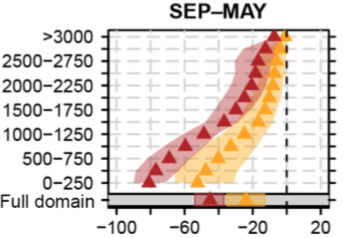
Paper: Future snowfall in the Alps
A recent paper by Prisco Frei and coauthors exploits the EURO-CORDEX regional climate scenarios to derive 21st century snowfall changes over the European Alps. Among others, a newly developed method to separate snowfall from total precipitation based on near-surface temperature conditions and accounting for subgrid-scale topographic variability is employed. Snowfall projections reveal a robust signal of decreasing snowfall amounts over most parts of the Alps. Domain and multi-model mean decreases by the end of the century amount to −25 and −45 % for RCPs 4.5 and 8.5, respectively. Snowfall in low-lying areas in the Alpine forelands could be reduced by more than −80 %. These decreases are driven by the projected warming and are strongly connected to an important decrease in snowfall frequency and snowfall fraction and are also apparent for heavy snowfall events. In contrast, high-elevation regions could experience slight snowfall increases in midwinter. These can be explained by a general increase in winter precipitation and by the fact that, with increasing temperatures, climatologically cold areas are shifted into a temperature interval which favors higher snowfall intensities.
The work originated from a Master thesis carried out in the “Climate and Water Cycle” group of ETH Zurich and has been jointly supervised by ETH and MeteoSwiss staff. It has been awarded the “Prix de Quervain 2017” Price for Polar and High Altitude Research and is available as external pageMeteoSwiss scientific reportcall_made.
Frei, P., S. Kotlarski, M. A. Liniger, and C. Schär, 2018: Future snowfall in the Alps: projections based on the EURO-CORDEX regional climate models, The Cryosphere, 12, 1-24, external pagehttps://doi.org/10.5194/tc-12-1-2018call_made.
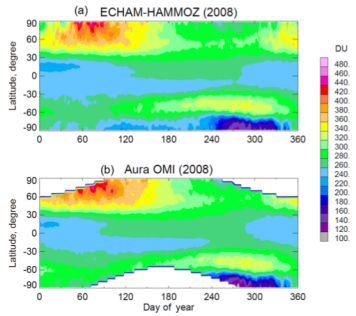
Paper: The chemistry–climate model ECHAM6.3-HAM2.3-MOZ1.0
The chemistry–climate model ECHAM-HAMMOZ contains a detailed representation of tropospheric and stratospheric reactive chemistry and state-of-the-art parameterizations of aerosols using either a modal scheme (M7) or a bin scheme (SALSA). This article describes and evaluates the model version ECHAM6.3-HAM2.3-MOZ1.0 with a focus on the tropospheric gas-phase chemistry. A 10-year model simulation was performed to test the stability of the model and provide data for its evaluation. The comparison to observations concentrates on the year 2008 and includes total column observations of ozone and CO from IASI and OMI, Aura MLS observations of temperature, HNO3, ClO, and O3 for the evaluation of polar stratospheric processes, an ozonesonde climatology, surface ozone observations from the TOAR database, and surface CO data from the Global Atmosphere Watch network. Global budgets of ozone, OH, NOx, aerosols, clouds, and radiation are analyzed and compared to the literature. ECHAM-HAMMOZ performs well in many aspects. However, in the base simulation, lightning NOx emissions are very low, and the impact of the heterogeneous reaction of HNO3 on dust and sea salt aerosol is too strong. Sensitivity simulations with increased lightning NOx or modified heterogeneous chemistry deteriorate the comparison with observations and yield excessively large ozone budget terms and too much OH. We hypothesize that this is an impact of potential issues with tropical convection in the ECHAM model.
Schultz, M. G., S., Stadtler, S. Schröder, D. Taraborrelli, B. Franco, J. Krefting, A. Henrot, S. Ferrachat, U. Lohmann, D. Neubauer, C. Siegenthaler-Le Drian, S. Wahl, H. Kokkola, T. Kühn, S. Rast, H. Schmidt, P. Stier, D. Kinnison, G. S. Tyndall, J. J. Orlando, and C. Wespes, 2018: The chemistry–climate model ECHAM6.3-HAM2.3-MOZ1.0, Geosci. Model Dev., 11, 1695-1723, external pagedoi.org/10.5194/gmd-11-1695-2018call_made.
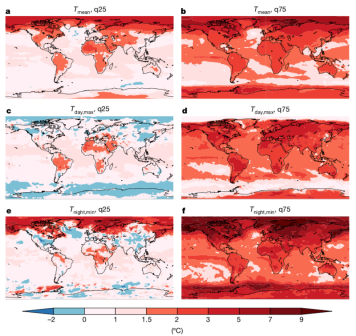
Paper: The many possible climates from the Paris Agreement’s aim of 1.5 °C warming
The United Nations’ Paris Agreement includes the aim of pursuing efforts to limit global warming to only 1.5 °C above pre-industrial levels. However, it is not clear what the resulting climate would look like across the globe and over time. In this paper, the authors show that trajectories towards a ‘1.5 °C warmer world’ may result in vastly different outcomes at regional scales, owing to variations in the pace and location of climate change and their interactions with society’s mitigation, adaptation and vulnerabilities to climate change. Pursuing policies that are considered to be consistent with the 1.5 °C aim will not completely remove the risk of global temperatures being much higher or of some regional extremes reaching dangerous levels for ecosystems and societies over the coming decades.
Seneviratne, S. I., J. Rogelj, R. Séférian, R. Wartenburger, M. R. Allen, M. Cain, R. J. Millar, K. L. Ebi, N. Ellis, O. Hoegh-Guldberg, A. J. Payne, C.-F. Schleussner, P. Tschakert, and R. F. Warren, 2018: The many possible climates from the Paris Agreement’s aim of 1.5 °C warming, Nature, 558, external pagehttps://doi.org/10.1038/s41586-018-0181-4call_made.
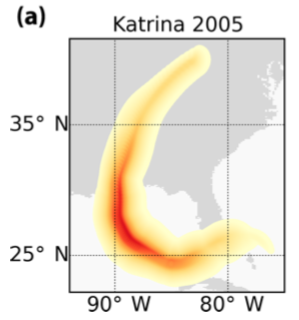
Paper: A global historical data set of tropical cyclone exposure (TCE-DAT)
Tropical cyclones pose a major risk to societies worldwide, with about 22 million directly affected people and damages of USD 29 billion on average per year over the last 20 years. While data on observed cyclones tracks and wind speeds are publicly available, these data sets do not contain information about the spatial extent of the storm and people or assets exposed. Here, we apply a simplified wind field model to estimate the areas exposed to wind speeds above 34, 64, and 96 knots. Based on available spatially explicit data on population densities and gross domestic product (GDP) we estimate (1) the number of people and (2) the sum of assets exposed to wind speeds above these thresholds accounting for temporal changes in historical distribution of population and assets and assuming fixed 2015 patterns. The associated spatially explicit and aggregated country-event-level exposure data (TCE-DAT) cover the period 1950 to 2015 and are freely available at https://doi.org/10.5880/pik.2017.011. It is considered key information to (1) assess the contribution of climatological versus socioeconomic drivers of changes in exposure to tropical cyclones, (2) estimate changes in vulnerability from the difference in exposure and reported damages and calibrate associated damage functions, and (3) build improved exposure-based predictors to estimate higher-level societal impacts such as long-term effects on GDP, employment, or migration. We validate the adequateness of our methodology by comparing our exposure estimate to estimated exposure obtained from reported wind fields available since 1988 for the United States. We expect that the free availability of the underlying model and TCE-DAT will make research on tropical cyclone risks more accessible to non-experts and stakeholders.
Geiger, T., K. Frieler, and D. N. Bresch, 2018: A global historical data set of tropical cyclone exposure (TCE-DAT), Earth Systems Science Data, 10 1: 185-194, 2018, external pagehttps://doi.org/10.5194/essd-10-185-2018call_made.

Paper: Marine Heatwaves are threatening marine ecosystems
Marine heatwaves (MHWs) are periods of extreme warm sea surface temperature that persist for days to months and can extend up to thousands of kilometres. Some of the recently observed marine heatwaves revealed the high vulnerability of marine ecosystems and fisheries to such extreme climate events. Yet our knowledge about past occurrences and the future progression of MHWs is very limited. Here we use satellite observations and a suite of Earth system model simulations to show that MHWs have already become longer-lasting and more frequent, extensive and intense in the past few decades, and that this trend will accelerate under further global warming. Between 1982 and 2016, we detect a doubling in the number of MHW days, and this number is projected to further increase on average by a factor of 16 for global warming of 1.5 degrees Celsius relative to preindustrial levels and by a factor of 23 for global warming of 2.0 degrees Celsius. However, current national policies for the reduction of global carbon emissions are predicted to result in global warming of about 3.5 degrees Celsius by the end of the twenty-first century, for which models project an average increase in the probability of MHWs by a factor of ~40. At this level of warming, MHWs have an average spatial extent that is approximately 20 times bigger than in preindustrial times, last on average ~110 days and reach maximum sea surface temperature anomaly intensities of 2.5 degrees Celsius. The largest changes are projected to occur in the western tropical Pacific and Arctic oceans. Today, a little less than 90 per cent of MHWs are attributable to human-induced warming, with this ratio increasing to nearly 100 per cent under any global warming scenario exceeding 2 degrees Celsius. Our results suggest that MHWs will become very frequent and extreme under global warming, probably pushing marine organisms and ecosystems to the limits of their resilience and even beyond, which could cause irreversible changes.
Frölicher, T. L., E. M. Fischer, and N. Gruber, 2018: Marine heatwaves under global warming, Nature, external pagedoi: 10.1038/s41586-018-0383-9call_made.
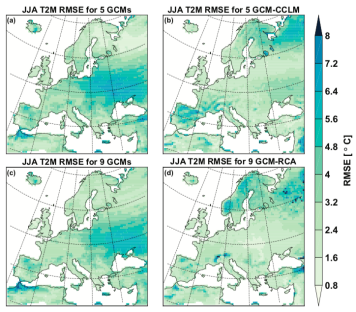
Paper: Regional climate models reduce biases of global models and project smaller European summer warming
The assessment of climate change is often based on complex model chains involving GCMs, RCMs and impact models. It is a common belief that the errors in such model chains behave approximately additive. If this hypothesis was true, the application of model chains would not lead to any intrinsic improvement except for higher-resolution details. Here, we investigate the bias patterns and climate change signals of two RCMs that have downscaled a comprehensive set of GCMs. Results show that the biases of the RCMs and GCMs are not additive and not independent. The two RCMs are systematically reducing the biases and modifying climate change signals of the driving GCMs, even on scales that are considered well resolved by the driving GCMs.
Sørland, S.L., C. Schär, D. Lüthi and E. Kjellström, 2018: Regional climate models reduce biases of global models and project smaller European summer warming. Env. Res. Letters, 13, 074017, external pagehttps://doi.org/10.1088/1748-9326/aacc77call_made.

